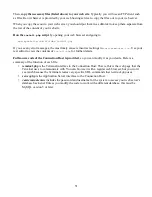
mind that there are some
limitations compared to a TriCoder
:
•
Unless your data structure is only one field repeating, you must use data identifiers with each data
field so that your Application Server can figure out what to do with each piece of data. In other
words, if all you are doing is scanning “Item”, “Item”, “Item”, you do not need identifiers. But, if
you are scanning “Item”, “Quantity”, “Item”, “Quantity”, then you must use identifiers so your
server can see the difference between “Item” and “Quantity” values.
•
Batch Mode Programs do not support tables. This means that while operating in Batch Mode, you
cannot do lookups or data validation using a table. Of course, you can easily do both in Real-Time
mode by writing these functions into your Application Server.
•
There is a new statement code for the Batch Program: “x” This instructs the Terminal to try to send
its stored data to the Server. The operator can also enter the key sequence “F1-shift-X” to force a
data-send attempt.
•
There is no “Data Review Mode” on the Terminal.
•
There is no “Programming Mode” on the Terminal. You must create and edit your Batch Program
file using the Batch Program Editor in the 7802 WiFi Terminal section of the Integrated Hardware
Utilities Program supplied on the CD with your Terminal. This software is also available for free
download.
See the chapter on how to build a Batch Program file for more information
Direct ASCII, Non Windows, and Cloud-Based Installations
It is possible to create a host application to control WiFi Terminals without using the ActiveX control, and
even without using Windows at all.
One scenario might be that you want a host program running on your PC (maybe it is a Mac or running
Linux). You are OK with using an un-modified Connection Host running somewhere out on the Web. In this
case, you will need to understand the native command language that the Terminal uses and build a way to
send and receive HTTP packets to and from the Connection Host. The structure of these packets is defined
(see SERVER.PHP in the Connection Host files). Building this kind of TCP communications into a program
is challenging, but a competent programmer should be able to handle it.
Another scenario might be that you want to do away with ActiveX and a client-based server altogether. You
want to control your Terminals directly from a Web server host and interface directly with a database
backend such as MySQL or MSSQL Server or whatever is your favorite. The way to do this is to modify
CLOUD.PHP (with the Connection Host distribution) to suit your application. Or, port the CLOUD.PHP
code to whatever is your favorite web programming environment.
65






























